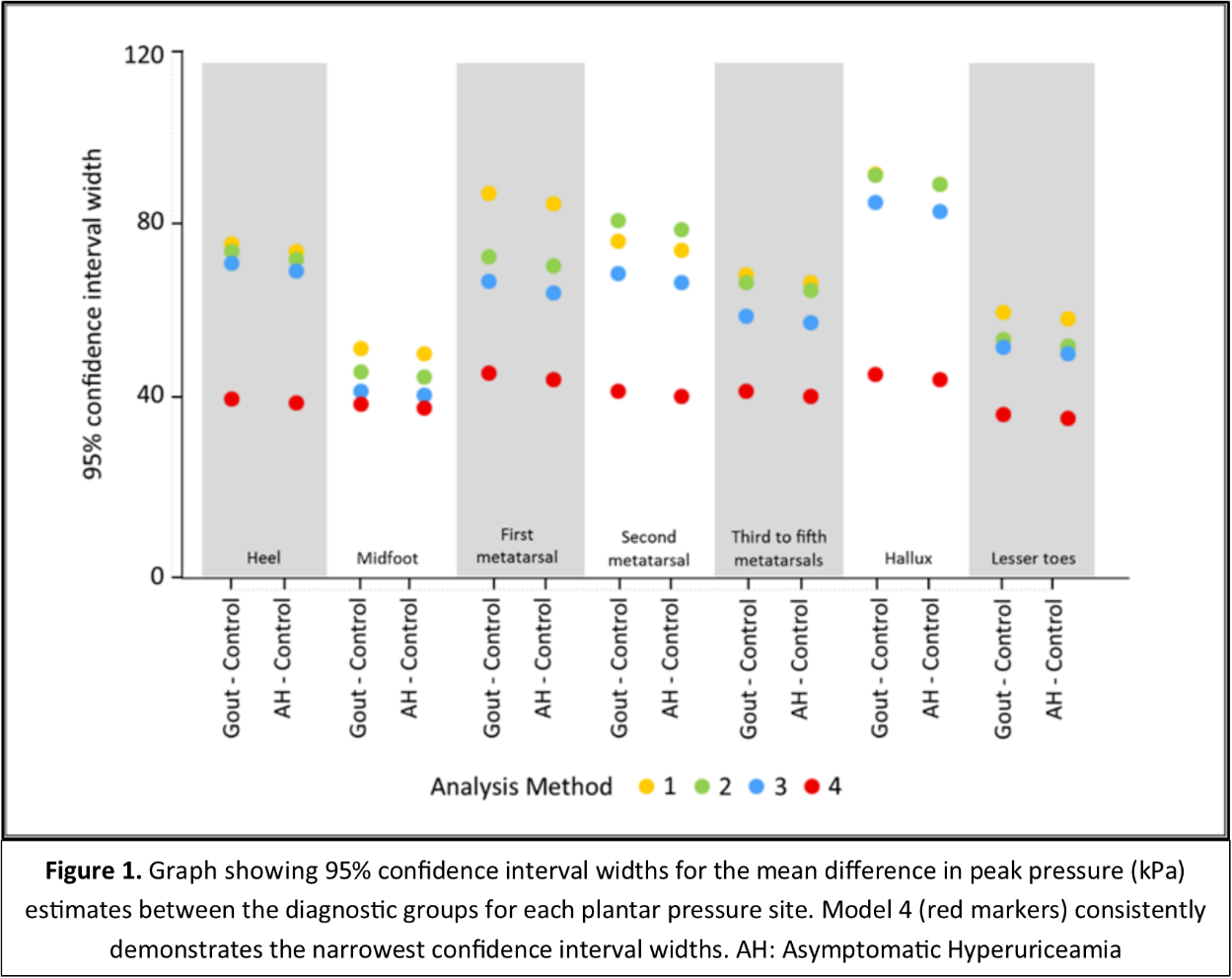Session Information
Session Type: ACR Poster Session C
Session Time: 9:00AM-11:00AM
Background/Purpose: Statistical techniques used in musculoskeletal research often inefficiently account for paired-limb measurements or the relationship between measurements taken from multiple sites within limbs. This study compared three commonly used analysis methods with a multivariate mixed-effects model which accounts for the association between limbs, sites, and trials and that utilises all information available from repeated trials.
Methods: Four analysis models were applied to an existing data set containing peak plantar pressure data, a continuous variable. The original study compared pressure during barefoot walking in people with gout (n = 25) or people with asymptomatic hyperuricaemia (n = 27) with normouricaemic controls (n = 34). Pressure data was collected for both feet over three walking trials. Peak pressure was calculated for each of 7 masked regions of the plantar foot (heel, midfoot, 1st metatarsal, 2nd metatarsal, metatarsals 3 to 4, hallux and lesser toes). The data set was analysed using the following 4 approaches: Model 1 analysed right foot data; Model 2 analysed data from a randomly selected foot; Model 3 averaged right and left foot data; Model 4 used all available data in a mixed-effects regression model which accounted for repeated measures taken for each foot, foot site and trial. Two comparisons were considered for all analyses: gout vs. normouricaemic control and asymptomatic hyperuricaemic vs. normouricaemic control. Age and body mass index were included in all analyses as covariates. For the purpose of model comparison, confidence interval widths for the mean differences between groups for each foot site were used as a criteria for statistical efficiency.
Results: Estimated mean differences in peak pressure between diagnostic groups for Analysis Models 1 to 3, were similar across all analysis methods, while the confidence interval widths for the mean differences were consistently smaller for Analysis Model 4 (Figure 1). The mean peak pressure estimates for each diagnostic group, for Analysis Models 1 to 3, were also similar across analysis methods, while confidence interval widths were again consistently lowest in Analysis Model 4. Model 4 also revealed significant between-group differences which were not detected in Models 1-3.
Conclusion: Adoption of a multivariate mixed-effects linear regression model efficiently addresses the issue of between-limb dependence in musculoskeletal research through retaining individual side and trial data, and utilising the relationship between site measurements on the same foot. The improved efficiency and power generated from this model produces more precise estimates compared to alternative approaches which discard or average data to take into account the paired nature of the data, and which model site measurements independently.
To cite this abstract in AMA style:
Stewart S, Pearson J, Rome K, Dalbeth N, Vandal A. Analysis of Data Collected from Right and Left Limbs: Accounting for Dependence and Improving Statistical Efficiency in Musculoskeletal Research [abstract]. Arthritis Rheumatol. 2017; 69 (suppl 10). https://acrabstracts.org/abstract/analysis-of-data-collected-from-right-and-left-limbs-accounting-for-dependence-and-improving-statistical-efficiency-in-musculoskeletal-research/. Accessed .« Back to 2017 ACR/ARHP Annual Meeting
ACR Meeting Abstracts - https://acrabstracts.org/abstract/analysis-of-data-collected-from-right-and-left-limbs-accounting-for-dependence-and-improving-statistical-efficiency-in-musculoskeletal-research/

